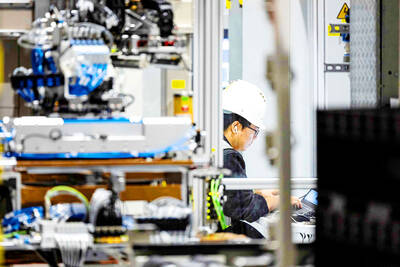Samsung Electronics Co plans to build a US$670 million plant to make mobile phone handsets in northern Vietnam, a Vietnamese official said yesterday.
The world's second largest handset maker has been pushing for the Vietnam plant for nearly a year and submitted the proposal to authorities in Bac Ninh Province earlier last month, said Nguyen Quang Thanh of the provincial planning and investment department.
"They still lack some papers," Thanh said. "Once they fill in all necessary papers, we will grant the investment license right away."
RAMPING UP
The plant will produce 30 million mobile phone handsets a year in the first stage and will gradually expand to produce 100 million units, he said. Bac Ninh is 30km northeast of Hanoi.
Samsung executives in Hanoi were not available for comment yesterday. But officials from the South Korean company had earlier said that they were considering Vietnam for its cheap labor.
In addition to Samsung's domestic handset plant at Gumi, some 260km southeast of Seoul, Samsung also has handset facilities in China, India and Brazil.
DRAWING INVESTORS
Vietnam is the 6th most attractive place for foreign investors behind China, India, Russia, the US and Brazil, said Phan Huu Thang, director of the Foreign Investment Department, quoting the 2007 World Investment Report from the UN Conference on Trade and Development.
Pledges for foreign investment in Vietnam surged nearly 70 percent last year to a record US$20.3 billion.

CHIP RACE: Three years of overbroad export controls drove foreign competitors to pursue their own AI chips, and ‘cost US taxpayers billions of dollars,’ Nvidia said China has figured out the US strategy for allowing it to buy Nvidia Corp’s H200s and is rejecting the artificial intelligence (AI) chip in favor of domestically developed semiconductors, White House AI adviser David Sacks said, citing news reports. US President Donald Trump on Monday said that he would allow shipments of Nvidia’s H200 chips to China, part of an administration effort backed by Sacks to challenge Chinese tech champions such as Huawei Technologies Co (華為) by bringing US competition to their home market. On Friday, Sacks signaled that he was uncertain about whether that approach would work. “They’re rejecting our chips,” Sacks

It is challenging to build infrastructure in much of Europe. Constrained budgets and polarized politics tend to undermine long-term projects, forcing officials to react to emergencies rather than plan for the future. Not in Austria. Today, the country is to officially open its Koralmbahn tunnel, the 5.9 billion euro (US$6.9 billion) centerpiece of a groundbreaking new railway that will eventually run from Poland’s Baltic coast to the Adriatic Sea, transforming travel within Austria and positioning the Alpine nation at the forefront of logistics in Europe. “It is Austria’s biggest socio-economic experiment in over a century,” said Eric Kirschner, an economist at Graz-based Joanneum

BUBBLE? Only a handful of companies are seeing rapid revenue growth and higher valuations, and it is not enough to call the AI trend a transformation, an analyst said Artificial intelligence (AI) is entering a more challenging phase next year as companies move beyond experimentation and begin demanding clear financial returns from a technology that has delivered big gains to only a small group of early adopters, PricewaterhouseCoopers (PwC) Taiwan said yesterday. Most organizations have been able to justify AI investments through cost recovery or modest efficiency gains, but few have achieved meaningful revenue growth or long-term competitive advantage, the consultancy said in its 2026 AI Business Predictions report. This growing performance gap is forcing executives to reconsider how AI is deployed across their organizations, it said. “Many companies

France is developing domestic production of electric vehicle (EV) batteries with an eye on industrial independence, but Asian experts are proving key in launching operations. In the Verkor factory outside the northern city of Dunkirk, which was inaugurated on Thursday, foreign specialists, notably from South Korea and Malaysia, are training the local staff. Verkor is the third battery gigafactory to open in northern France in a region that has become known as “Battery Valley.” At the Automotive Energy Supply Corp (AESC) factory near the city of Douai, where production has been under way for several months, Chinese engineers and technicians supervise French recruits. “They